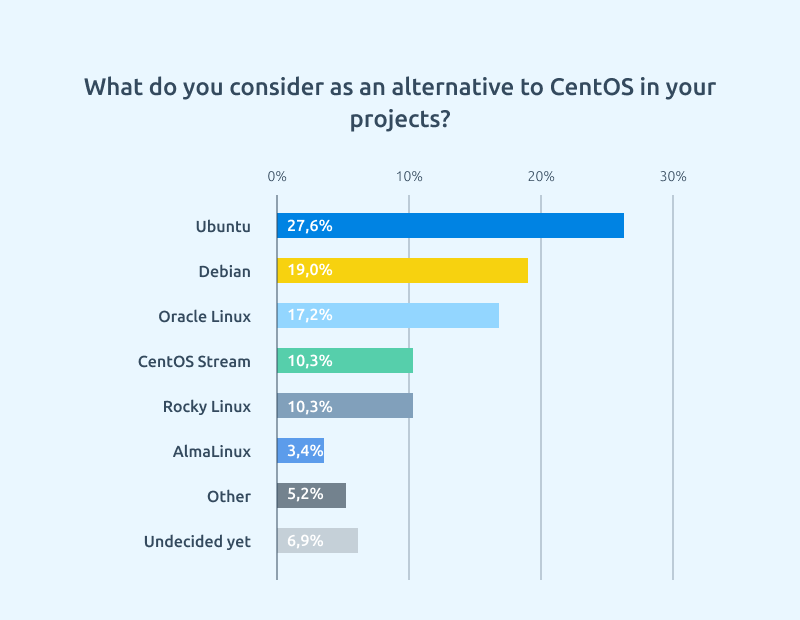In December 2020, RedHa announcedits intention to stop the development and support of CentOS in late 2021. The EOL for the seventh version of CentOS 7, however, remains unchanged — until 2024.
Why RedHat is stopping support for CentOS
The CentOS project has been around for more than 15 years. Red Hat acquired it in 2014 and announced that it would sponsor it. However, in 2019, Red Hat was taken over by IBM. Apparently, the new top management made a different decision. Red Hat explained it by optimizing resources — they decided to devote them to the development of CentOS Stream. Probably the company wants to concentrate on the corporate segment and the basic business function of any company — making a profit.
When support for CentOS ends in late 2021 and only CentOS Stream will be supported, all non-paying users will move to the tester category. The company will use them to test updates to its commercial product RHEL.
Some estimates put the share of CentOS in the Linux community at around 16-20%.
CentOS as an open source project
CCentOS is one of the most popular server OS distributions. IT engineers gave it preference because CentOS offered many of the features of Red Hat Enterprise Linux. Yes, it was without support, but free. With the CentOS distribution, the user received a set of stable tools — PostgreSQL, MySQL, nginx and others.
Under the GNU General Public License, RH will continue to publish the source code of the project. The intention to take up this project was already announced by AlmaLinux, и Rocky Linux.
AlmaLinux — is a CloudLinux project. It was founded by Igor Seletsky, a native of Ukraine. AlmaLinux is a binary compatible fork of RHEL which can be used for free. CloudLinux is committed to maintaining its distribution until at least 2029. One million dollars per year will be invested into the project.. However, setting up an open-source project means that the community will be able to develop AlmaLinux further.
Rocky Linux belongs to a startup called Ctrl IQ by Gregory Kurtzer. Interestingly, this is the same man who once created the original CentOS. The company has already raised $4 mln. of investments to develop a software stack, one element of which is a free "clone" of the commercial Red Hat Enterprise Linux. Ctrl IQ assures that Rocky Linux will remain the property of the open-source community, despite these financial injections from companies.
Oracle
In December 2020, Oracle presented its tool for easy and fast migration to Oracle Linux. They promise binary compatibility and minimal migration problems for new users. The company provided a script for the migration of production systems. It automatically replaces CentOS-specific packs with equivalents from the Oracle Linux distribution. Migration from CentOS 7 and 8 is supported.
There are a number of restrictions for migration. This is the lack of support for systems that use third-party tools for centralized management (such as Spacewalk, Foreman and Uyuni). Only the main OS repositories are processed. Connecting external repositories, such as EPEL, must be done manually by the user. Compatibility with packages from external repositories is assumed but not guaranteed
For intermediate releases of RHEL, the Oracle Linux version is published within 5 business days. The Oracle distribution is fully compatible with RHEL and allows to use both regular packages with kernel from RHEL and its own Unbreakable Enterprise Kernel, which includes additional features. Packages with the RHEL kernel are monolithic. In contrast, all changes to the Unbreakable Enterprise Kernel are published in a Git-repository with the division into separate patches and details of the change log. This increases the transparency and predictability of the system's update behavior for users.
An additional bonus from Oracle will be support for a high-performance and reliable network file system OCFS2. It allows you to share the storage connected via iSCSI among several Linux systems.
Oracle publishes installation ISO images, which arefree of charge and restrictions. Oracle Linux provides unlimited and free access to yum repository кwith package updates that include fixes for bug and security issues. Access to package code, binary builds, updates and patches is free for all uses, including commercial applications.. Further distribution of packages and builds is allowed without signing any agreements with Oracle and without removing Oracle trademarks from third-party supplies. Oracle has paid support — this can be an advantage for many companies.
Ubuntu
Canonical launched its marketing campaign inviting to migrate to Ubuntu. Canonical cites the data that it is one of the most preferred OS distributions by developers and IT students. It is ahead of MacOS and slightly behind Windows. Other benefits of Ubuntu claimed by Canonical:
- predictability,
- reliability,
- security,
- excellent scaling opportunities,
- support for hybrid cloud infrastructures,
- paid technical support.
Ubuntu also supports new hardware very well. CentOS has always been conservative in this matter.
However, Ubuntu also has the disadvantage of being a Debian-based distribution. Therefore, an easy migration from the RH-based CentOS distribution is hardly possible. Ubuntu is more likely to attract customers planning to develop new IT projects than to encourage migration.
Ubuntu has always been interesting to use in IT projects. For example, we have selected Ubuntu as an additional supported OS in addition to CentOS for the VMmanager team. In autumn 2020, we implemented LXD clusters based on Ubuntu with ZFS storage support.
What OS will be chosen instead of CentOS. ISPsystem survey
We decided to do our own research to see who will take the CentOS niche. To do this, we conducted a sample survey among representatives of our customers: DevOps engineers, IT directors, system administrators and architects. Respondents were asked: "What do you consider as an alternative to CentOS in your projects?"

The survey showed no unexpected results. The following conclusions can be drawn:
- Most professionals consider Debian-based distributions as an alternative for their projects.
- Many people are not ready to migrate from RH-based distributions and are considering alternative RHEL clones.
- Some of the experts we surveyed are in no hurry to decide and plan to wait quietly until 2021 or 2024, carefully considering the alternatives on the operating system market.
None of the respondents expressed the intention to switch to RHEL. Perhaps these professionals were not included in our survey.
What will happen to the market after CentOS support ends
In my opinion, the high-profile CentOS story is not a disaster for the community. The market share of linux distributions in 2021 will grow, as before. Some users will switch to RHEL and meet the expectations of this company. But most likely one of the free RHEL clones will take the place of CentOS: Oracle, Alma, Rocky or other. We will find out which one soon, and maybe even in 2021. Canonical will benefit from this story — most users are willing to consider Ubuntu for their IT projects. This is aided by a marketing campaign, paid tech support, good support for fresh hardware and a huge community of users. All of this will cement Ubuntu's status as one of the most popular operating systems in the world.
Tell us in the comments which operating system you will choose for your project instead of CentOS.


